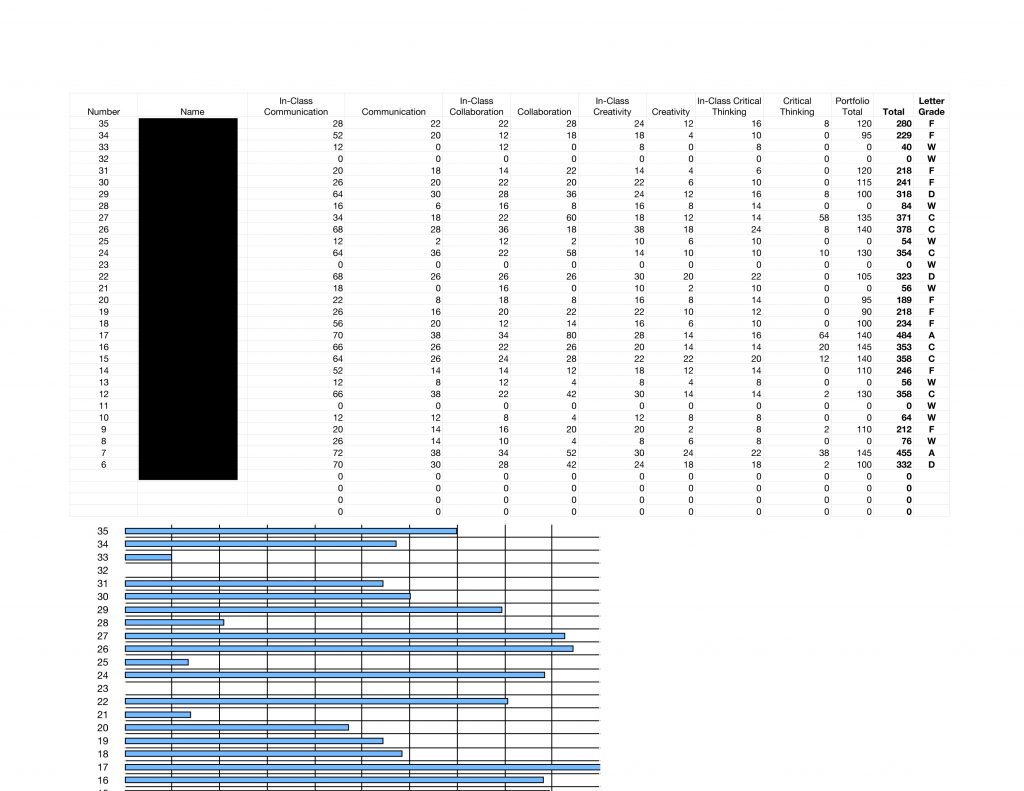(Originally published on nmc.org on August 15, 2013)
In every class I teach, I struggle with some fundamentals of our industrialized education system that I cannot change but which seriously inhibit creative exploration of available information. I always dread being asked, “How do I get an ‘A’ in this class?” or even worse: “How do I pass this class?” I never seem to get this question: “What can I learn in this class?” This should not surprise me because our students have been well trained by the time they get to college. They see little connection between school and learning. Instead, it’s about beating the system. This is particularly true for most of my students who struggled in their K-12 classes and may have only graduated by the skin of their teeth. A fixation on grades is second nature to them (as it is to my own kids).
Grades have a pernicious effect on true learning and creative thought. As someone who has always loved learning for learning’s sake, I find this particularly frustrating. I have always personally been able to push the administrivia of learning to the background, in part because I never really feared failing a class in high school or college. My students are not so lucky and, as a consequence, evaluation becomes central to their educational experiences. Daniel Pink, drawing on decades of psychological research, shows fairly conclusively that external motivators like money and grades destroy our capacity for creative thought.
As a consequence, I feel like the industrialized educational system is always working against my educational goals. It is a lot harder to evaluate skills and assess final product when everyone is looking past that to what their final grade will be. I spend a lot of time and effort (it is often a central focus to my pedagogical strategy) trying to push grades to the background or at the very least to try to trivialize their effects but it’s a little like trying to hide green beans in chocolate cake. The taste can sometimes be disconcerting to the unprepared. I fight this battle with my own kids in K-12 and it’s hard with sustained effort, and even more difficult within the constraints of a 16-week class that meets once or twice a week.
In my most recent effort, I attempted to make “kinder, gentler” grading the focus. I did this by implementing a cumulative point system. No one failed assignments. It was all a process of accruing points. Furthermore, I wanted to achieve a certain level of gamification using insights from Tom Chatfield such as creating many small rewards and providing them with rapid feedback.
To achieve these goals, I gave each student a code and created a spreadsheet, which, in turn, created a bar graph to show how many points everyone had accrued relative to the rest of the class and relative to the bars necessary to achieve a grade.
Achieving rapid feedback was one area in which I failed the students. I was not able to turn around the grading fast enough to give them immediate feedback. Therefore, I don’t know if this aspect of the class was given a fair shake. As I discuss below, one issue that I encountered was the time required in developing a point system that did what I wanted to it to do. The delays in getting this finalized and workable put my grading way behind. Applying lessons learned in future semesters should alleviate this issue somewhat.
The other area that Chatfield mentioned, that of frequent, small rewards, actually caused complaints at the end of the semester is that spreading out the reward structure required constant attention on the students’ part. While we, as teachers, expect the students to put in consistent attention in the class, the reality is that most students want to be able to check in only on the week of a test or a paper deadline and essentially coast through the remaining weeks of the semester.
Even though I made expectations clear, the students were shocked about 2/3 of the way through the semester that they had failed to accumulate enough points. At this point, the point accumulations reflected their efforts posting on Google+ as well as their participation in in-class activities. To cite just one yardstick, I asked them to post twice on Google+ per week as a minimum activity. One post was in response to a prompt. The other was to bring in an outside source relating to the topic of the week. At that point in the semester (the 7thweek), they should have had a minimumof 14 posts. About 1/3 of the class had less than 5. I gave them opportunities to catch up point-wise by commenting on others’ posts but this was a real struggle for many of them. I did not allow them to go back and make new posts as this would have been unfair to those who did the work on time.
The second major part of my evaluation strategy was to be mindful of precisely what I was attempting to evaluate. The students and I had a frank discussion what kinds of skills they needed to be practicing in college and how the course could facilitate that. I introduced them to the National Education Association’s: “Four C” rubric as I think it encapsulates what I think is important to get out of college nicely and suggested that we use these four variables (Communication, Collaboration, Creativity, and Critical Thinking) to evaluate their performance. I broke it down as follows:
- Communication – How well did students present themselves? These points were given for things like the quality and frequency of posts on Google+, quality of presentations in-class, and the clarity of their portfolio website.
- Collaboration – How well did students work together to achieve the common goal of learning? These points were given for things like group self-evaluations for in-class debates, presentations, and commenting on Google+ posts.
- Creativity – How effective were students in pulling together evidence into an argument? These points were given for presentation arguments, debate arguments, and the creative use of evidence in Google+ posts.
- Critical Thinking – How reflective were students about the arguments they were presenting? These were the hardest points to earn. Students had to demonstrate self-awareness in arguments, an ability to see both sides of an issue, and to be able to integrate that into their presentations, posts, and portfolio.
The problem that occurred as a result of attempting to achieve this level of granularity was that I created four-headed hydra trying to translate the Four-C’s into a workable grading scheme. This was one of the key reasons that I didn’t get feedback to the class as quickly as I wanted to. I essentially ended up developing a manual Learning Analytics system to translate the variables into points. The net effect was that I forced myself into an incredibly complex grading system that took me half the semester to figure out. The extent to which I applied tech was limited creating a complete 12-page workbook in Numbers (it did better graphing than Excel). Frequent rewards meant that I had to deal with extremely small numbers and never really achieved the level of finesse that I usually demand from my grading.

Over and above the logistical hurdles that I created for myself, I don’t think the grading system taught the students much, if anything, about their relative skills in the four areas. I did discuss how I was assigning points while discussing grades within the class. However, I could tell the students were almost entirely fixated on the total points, not how they could earn points in communication versus critical thinking, for instance.
My struggles with the grading system and my ultimate failure in developing a more constructive system was perhaps the most disappointing result from this part of the experiment and goes back to my original dilemma. I never figured out how to move the discussion beyond, “How do I pass this class?” to “What can I learn that might be useful to me?”
I am not going to be able to get beyond the fundamental realities of the need for a final grade in the class as long as the larger educational system uses the transcript/degree as the final yardstick of educational achievement. Perhaps a more successful application of gamification principles would at least make this part of the class more fun and trivial. The students themselves live with fundamental contradictions in their own attitudes toward their educational investments. On the one hand, they play the grading game with seeming indifference when it comes to the value of an individual class. On the other hand, they are totally fixated on their final grade as the only valuable thing they get out of wasting their time in a class they don’t want to take in the first place. New Media may give us some routes forward but until it undermines these fundamental contradictions in assessment, technology’s transformative power will be very limited. Solving the grader’s dilemma may require adjustments beyond the capacity of any individual educator to achieve but I’ll keep trying. I’m stubborn.

